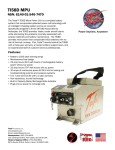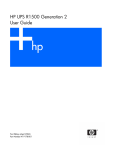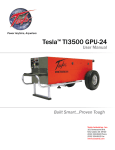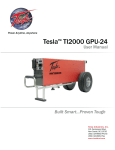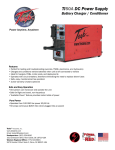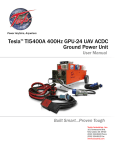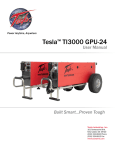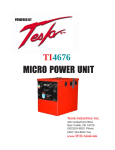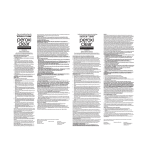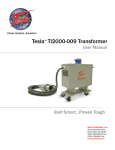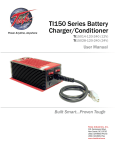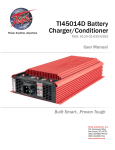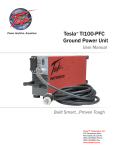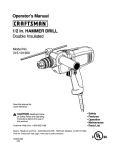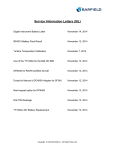Download Tesla™ TI58D MPU-24 - Tesla™ Industries Inc
Transcript
Power Anytime, Anywhere Tesla™ TI58D MPU-24 User Manual Built Smart...Proven Tough Tesla Industries, Inc. 101 Centerpoint Blvd. New Castle, DE 19720 (302) 324-8910 Phone (302) 324-8912 Fax www.teslaind.com NOTE: All users must read this entire manual prior to operating the TI58D MPU-24. The TI58D MPU-24 is a limited maintenance-free and sealed unit. No repairs are authorized. Warranty will be voided if unit is tampered with in any way, or if unauthorized repairs are made. For technical support please contact: TESLA™ INDUSTRIES INCORPORATED 101 CENTERPOINT BLVD. CENTERPOINT INDUSTRIAL PARK NEW CASTLE, DELAWARE 19720 PHONE: (302) 324-8910 FAX: (302) 324-8912 WEBSITE: www.teslaind.com EMAIL: [email protected] CAUTION Shock Hazard Potential Improper use or failure to follow instructions in this user manual can result in unit damage and/or injury or death by electrical shock. Any attempts to open or examine the inside of the TI58D MPU-24 via a tool or device (borescope, probe, etc.) can result in unit failure and/or injury by electrical shock. This MPU is maintenance free and should not be opened or disassembled for any reason. Always protect the unit from short circuit. Shipping Hazards: The TI58D MPU-24 contains sealed, dry cell rechargeable batteries that do not pose a shipping hazard. No part of this manual may be reproduced or transmitted in any form or by any means, electronic or mechanical, including photocopying, recording, or any information storage and retrieval system, without prior written permission from Tesla™ Industries, Inc. Copyright © 2015 by Tesla™ Industries, Incorporated. All rights reserved. 07-13-15 Form #: SDS 853027 Revised: 05/14/15 SAFETY DATA SHEET I. PRODUCT IDENTIFICATION Chemical Trade Name (as used on label): Tesla™ Industries, Inc. Synonyms: Sealed Lead Acid Battery, VRLA Battery Chemical Family/Classification: Sealed Lead Battery Telephone: For information, contact Tesla™ Industries, Inc. Customer Service Dept. at 302-324-8910 Manufacturer's Name/Address: Tesla™ Industries, Inc. 101 Centerpoint Blvd. New Castle, DE 19720-4180 II GHS HAZRDS IDENTFICATION HEALTH Acute Toxicity (Oral/Dermal/Inhalation) Skin Corrosion/Irritation Eye Damage Reproductive Carcinogenicity (lead compounds) Carcinogenicity (acid mist) Specific Target Organ Toxicity (repeated exposure) GHS LABEL: HEALTH Supersedes: NEW ECO #: 1001584 24-Hour Emergency Response Contact: CHEMTREC DOMESTIC: 800-424-9300 Category 4 Category 1A Category 1 Category 1A Category 1B Category 1A CHEMTREC INT'L: 703-527-3877 ENVIRONMENTAL Aquatic Chronic 1 Aquatic Acute 1 PHYSICAL Explosive Chemical, Division 1.3 ENVIRONMENTAL PHYSICAL Category 2 Hazard Statements Precautionary Statements DANGER! Wash thoroughly after handling. Causes severe skin burns and eye damage. Do not eat, drink or smoke when using this product. Causes serious eye damage. Wear protective gloves/protective clothing, eye protection/face protection. May damage fertility or the unborn child if ingested or Avoid breathing dust/fume/gas/mist/vapors/spray. inhaled. Use only outdoors or in a well-ventilated area. May cause cancer if ingested or inhaled. Causes skin irritation, serious eye damage. Causes damage to central nervous system, blood and Contact with internal components may cause irritation or severe burns. Avoid contact with internal acid. kidneys through prolonged or repeated exposure. Irritating to eyes, respiratory system, and skin. May form explosive air/gas mixture during charging. Extremely flammable gas (hydrogen). Explosive, fire, blast, or projection hazard. III. HAZARDOUS INGREDIENTS/IDENTIFY INFORMATION Components CAS Number Approximate % by Weight Inorganic Lead Compound: Lead 7439-92-1 45 - 60 Lead Dioxide 1309-60-0 15 - 25 Tin 7440-31-5 0.1 - 0.2 Sulfuric Acid Electrolyte (Sulfuric Acid/Water) 7664-93-9 15 - 20 Case Material: 5 - 10 Polypropylene 9003-07-0 Polystyrene 9003-53-6 Styrene Acrylonitrile 9003-54-7 Acrylonitrile Butadiene Styrene 9003-56-9 Styrene Butadiene 9003-55-8 Polyvinylchloride 9002-86-2 Polycarbonate, Hard Rubber, Polyethylene 9002-88-4 Polyphenylene Oxide 25134-01-4 Polycarbonate/Polyester Alloy -Other: Absorbent Glass Mat -1-2 Inorganic lead and sulfuric acid electrolyte are the primary components of every battery manufactured by Tesla™ Products. There are no mercury or cadmium containing products present in batteries manufactured by Tesla™ Products. Page 1 SAFETY DATA SHEET Form #: SDS 853027 Revised: 05/14/15 Supersedes: NEW ECO #: 1001584 IV. FIRST AID MEASURES Inhalation: Sulfuric Acid: Remove to fresh air immediately. If breathing is difficult, give oxygen. Consult a physician Lead: Remove from exposure, gargle, wash nose and lips; consult physician. Ingestion: Sulfuric Acid: Give large quantities of water; do not induce vomiting or aspiration into the lungs may occur and can cause permanent injury or death; consult a physician Lead: Consult physician immediately. Skin: Sulfuric Acid: Flush with large amounts of water for at least 15 minutes; remove contaminated clothing completely, including shoes. If symptoms persist, seek medical attention. Wash contaminated clothing before reuse. Discard contaminated shoes. Lead: Wash immediately with soap and water. Eyes: Sulfuric Acid and Lead: Flush immediately with large amounts of water for at least 15 minutes while lifting lids Seek immediate medical attention if eyes have been exposed directly to acid. V. FIRE FIGHTING MEASURES Flash Point: N/A Flammable Limits: LEL = 4.1% (Hydrogen Gas) UEL = 74.2% (Hydrogen Gas) Extinguishing Media: Carbon dioxide; foam; dry chemical. Avoid breathing vapors. Use appropriate media for surrounding fire. Special Fire Fighting Procedures: If batteries are on charge, shut off power. Use positive pressure, self-contained breathing apparatus. Water applied to electrolyte generates heat and causes it to spatter. Wear acid-resistant clothing, gloves, face and eye protection. Note that strings of series connected batteries may still pose risk of electric shock even when charging equipment is shut down. Unusual Fire and Explosion Hazards: Highly flammable hydrogen gas is generated during charging and operation of batteries. To avoid risk of fire or explosion, keep sparks or other sources of ignition away from batteries. Do not allow metallic materials to simultaneously contact negative and positive terminals of cells and batteries. Follow manufacturer's instructions for installation and service. VI. PRECAUTIONS FOR SAFE HANDLING AND USE Spill or Leak Procedures: Stop flow of material, contain/absorb small spills with dry sand, earth, and vermiculite. Do not use combustible materials. If possible, carefully neutralize spilled electrolyte with soda ash, sodium bicarbonate, lime, etc. Wear acid-resistant clothing, boots, gloves, and face shield. Do not allow discharge of unneutralized acid to sewer. Acid must be managed in accordance with local, state, and federal requirements. Consult state environmental agency and/or federal EPA. VII. HANDLING AND STORAGE Handling: Unless involved in recycling operations, do not breach the casing or empty the contents of the battery. There may be increasing risk of electric shock from strings of connected batteries. Keep containers tightly closed when not in use. If battery case is broken, avoid contact with internal components. Keep vent caps on and cover terminals to prevent short circuits. Place cardboard between layers of stacked automotive batteries to avoid damage and short circuits. Keep away from combustible materials, organic chemicals, reducing substances, metals, strong oxidizers and water. Use banding or stretch wrap to secure items for shipping. Storage: Store batteries in cool, dry, well-ventilated areas with impervious surfaces and adequate containment in the event of spills. Batteries should also be stored under roof for protection against adverse weather conditions. Separate from incompatible materials. Store and handle only in areas with adequate water supply and spill control. Avoid damage to containers. Keep away from fire, sparks and heat. Keep away from metallic objects which could bridge the terminals on a battery and create a dangerous short-circuit. Charging: There is a possible risk of electric shock from charging equipment and from strings of series connected batteries, whether or not being charged. Shut-off power to chargers whenever not in use and before detachment of any circuit connections. Batteries being charged will generate and release flammable hydrogen gas. Charging space should be ventilated. Keep battery vent caps in position. Prohibit smoking and avoid creation of flames and sparks nearby. Wear face and eye protection when near batteries being charged. For expanded detailed info, download the PDF online at... http://www.teslaind.com/PDF/chart/Tesla-Safety-Data-Sheet.pdf or go to http://www.teslaind.com/support-manuals.php and click on “Battery Safety Data Sheet” link under “Battery Info” heading. or use the QR Code to the right. Page 2 Table of Contents Section 1 – Safety Review 1.1 – Safety Notices 1.2 – Symbols 1.3 – Hazards 1.4 – Important Safety Precautions 1.5 – Extreme Environments 1 1 1 2 2 2 Section 2 – Product Overview 2.1 – Introduction 2.2 – Indication of Terms: Shall, Should, and May 2.3 – Front Panel Overview 2.4 – General Specifications 2.5 – Physical Dimensions 2.6 – Airflow Ports 2.7 – Operating Position 2.8 – “Push to Test” Button and LED Status Indicator 2.9 – Maintenance Check 2.10 – Pre-Installation Procedures 2.11 – TI58D MPU-24 Installation 3 3 3 4 5 6 6 7 8 9 9 10 Section 3 – Operating Procedures 3.1 – Operating Procedures 3.2 – General 3.3 – Operating Limits and Restrictions 3.4 – Performance 3.5 – Engine Starting Power 3.6 – Temperature Specifications 3.7 – Environmental 3.8 – Transporting Unit 3.9 – Normal Functional Test Procedures 3.10 – Regulated 28.5 VDC Ground Power 3.11 – Regulated AC Power 3.12 – Charging Unit 11 11 11 11 11 12 13 14 14 15-16 17 17-18 19 TI58D MPU-24 Section 4 – Post Operations 4.1 – General 4.2 – After Use 4.3 – Power Cell Recharge 20 20 20 20-21 Section 5 – Unit Care and Maintenance 5.1 – Unit Care 5.2 – Unit Servicing 5.3 – Packaging and Shipping 22 22 23 23 Section 6 – Frequently Asked Questions 24-26 Section 7 – Performance Data 7.1 – Purpose 7.2 – General 7.3 – Data Basis 7.4 – Specific Conditions 7.5 – General Conditions 7.6 – Temperature Conversion Chart 7.7 – Output Voltage 7.8 – Maximum Output Current 27 27 27 27 27 27 28 29 29 Section 8 – Optional Accessories 8.1 – Tesla™ Shipping Case 8.2 – Tesla™ AC Line Cords 30 30 30 Appendix A Repair Request Form 31-35 37 TI58D MPU-24 Abbreviations and Symbols Abbreviations that may be used within the text, headings and titles of this manual. LIST OF ABBREVIATIONS Abbreviation ac AFT AWG amp or A cont °C °F dc EFF ft FWD GPU Hr Hz kg kHz kW LED max MΩ min MPU NEMA Ω PF PFC rms THD TMDE UAV Vac Vdc W Definition Alternating Current Airflow Technology American Wire Gauge Ampere Continuous Degree Celsius Degree Fahrenheit Direct Current Efficiency Feet Forward Ground Power Unit Hour Hertz Kilograms Kilohertz Kilowatts Light Emitting Diode Maximum megaohm Minimum Micro Power Unit National Electrical Manufacturers Association ohm power factor power factor correction root-mean-square Total Harmonic Distortion Test, Measurement, & Diagnostic Equipment Unmanned aerial vehicle Volts, Alternating Current Volts, Direct Current watts TI58D MPU-24 Section 1 – Safety Review 1.1 - Safety Notices Safety notices appear throughout this manual to alert the user to important information regarding proper installation, operation, maintenance and storage of the unit. These notices, as illustrated below, contain a key word that indicates the level of hazard and a triangular icon that indicates the specific type of hazard. ! WARNING Indicates a condition, operating procedure or practice, which if not adhered to could result in serious injury or death. ! CAUTION Indicates a condition or operating procedure, which if not strictly adhered to could result in damage or destruction of equipment. ! NOTE Indicates a condition, operating procedure or practice, which is essential to highlight. 1.2 - Symbols The following symbols will appear within the warning triangles to alert the user to the specific type of danger or hazard. ! General Warning Electrical Hazard Battery Warning Explosion Hazard Fire Hazard Guard from Moisture Figure 1.2.1 – Different types of hazard and caution symbols TI58D MPU-24 1 1 Safety Review 1.3 – Hazards WARNING Shock Hazard Potential Severe injury or death from electrical shock may occur, if either user or the unit is wet, while the unit is connected to a power source. If the unit has come into contact with water, disconnect ac power from the ac source. If AC Input Circuit Breaker has tripped due to water infiltration, DO NOT try to reset it with the ac line voltage attached. WARNING Shock Hazard Potential Severe injury or death from electrical shock can occur when damp electrical plugs are connected to the unit. Before making any connections, turn off unit. Failure to use proper grounding can cause potential shock hazard! In different countries, the power cord may require the use of a plug adapter to achieve plug style compatibility for operation. Use only adapters with proper grounding mechanism. 1.4 – Important Safety Precautions WARNING Fire/Explosion Hazard Potential Severe injury or death from fire or explosion can occur if electrical sparks are produced near fuel vapors. DO NOT CONNECT ac power supply WHILE FUELING. AC power functions of unit shall not be operated during any fuel handling operation. Power output is restricted to dc power only. Figure 1.3.1 – Proper Ground Figure 1.3.2 – Proper Ground Figure 1.3.3 – Improper Ground Plug with Grounding Pin 1.5 –Grounded Extreme Environments CAUTION CAUTION Adapter with Grounding Mechanism (Secured to Outlet) Plug with No Grounding Pin Unit Damage Potential Unit Damage Potential The unit’s charger temperature switch automatically disables the unit when the internal temperature exceeds The use(65°C). of unapproved ac power will damage the unit. and Check the If the unit shuts down, move the unit 150°F This protects the unit from overheating damage. Inputa Voltage Selector Switch in blue) towhen ensure into cooler environment such window as shade(outlined or air conditioning possible. Perform a full function test, after the unit switch setting (115V or 230V) matches the ac power source has been allowed to cool, prior to use. (hangar wall, flight line ac power) prior to connecting the unit for recharging. 1.4 – Important Safety Precautions WARNING Fire/Explosion Hazard Potential Severe injury or death from fire or explosion can occur if electrical sparks are produced near fuel vapors. DO NOT CONNECT 120 or 240 Vac power supply WHILE FUELING. Do not charge the MPU using a 120-240 Vac Power during any fuel handling operation. Power output is restricted to 24 Vdc power only. 2 TI58D MPU-24 Section 2 – Product Overview 2.1 – Introduction Thank you and congratulations on the purchase of your new TI58D MPU-24. The TI58D MPU-24 provides 24 volt dc electrical power for aircraft engine starting and 24 or 28.5 volts for ground maintenance, avionics/electrical trouble shooting and testing. The observance of procedures, limitations and performance criteria is essential to ensure peak operating efficiency and to maximize operational capabilities and life of the unit. The TI58D’s high capacity power cells and circuity are encased in a rugged enclosure, and are designed to replace the original batteries in the OH58D Kiowa Warrior helicopter. The internal circuitry incorporates an intelligent recharging system that allows the MPU to rapidly recharge from either the aircraft generator or from a standard 110 Vac or 220 Vac power source. The unit is also equipped with a built-in capacity meter that also serves as a recharge state indicator. This manual contains the complete operating instructions and procedures for the TI58D MPU-24 needed to safely and efficiently operate this MPU. Figure 1.1.1 – TI58D MPU-24 2.2 – Indication of Terms: Shall, Should and May Within this technical manual the word “shall” is used to indicate a mandatory requirement for proper operation and warranty purposes. The word “should” is used to indicate a non-mandatory but preferred method of accomplishment. The word “may” is used to indicate an acceptable method of accomplishment. TI58D MPU-24 3 2 Product Overview 2.3 – Front Panel Overview 1 2 6 3 4 5 7 8 1. Nylon Carrying Strap - Permanently attached to the unit to provide easy transport and placement into aircraft. 2. 24 Vdc Capacity Meter – Indicates the 24V battery charge state/power output status. 3. “Press for Capacity” Button – Displays current battery charge state when pressed. 4. AC Input Circuit Breaker– Trips if overcurrent fault condition occurs. 5. AC Input Connector – Connects to Single Phase 100-260 Vac line voltage. 4 6. Air Outlet Port - Provides airflow for cooling internal electronics. 7. 24 Vdc Output Connector – Provides 24 Vdc to 28.5 Vdc @ 10 A continuous. 8. Dummy Plug Receiver TI58D MPU-24 Product Overview 2 2.4 – General Specifications Electrical AC Input Power: • Operates and charges from single phase 100-260 Vac 50/60 Hz • 5.5 amps @ single phase 120 Vac 60 Hz - 660 Watts • 2.75 amps @ single phase 240 Vac 60 Hz - 660 Watts DC Output Power: • 1500 peak starting amps • 10 amps continuous @ 28.5 Vdc - 285 watts (when plugged into ac power) • 33 amp hours (797 watt hours) with ac power • 23 amp hours (512 watt hours) of rechargeable battery power without ac Recharge Rate From Full Discharge: • 143 minutes @ 25°C Size: • 14.1” L x 6.7” W x 9.1” H • 358.1 mm x 170.2 mm x 231.1 mm Weight: • 52 lbs (23.58 kg) Operating Temperature: • -40°C to +60°C (-40°F to 140°F) without ac power • -40°C to +55°C (-40°F to 131°F) with ac power Storage Temperature: • -65°C to +105°C (-85°F to 221°F) Cell Capacity: • +40°C • +25°C • +00°C • -20°C • -40°C TI58D MPU-24 110% ± 05% 100% ± 05% 80% ± 05% 65% ± 10% 50% ± 10% 5 2 Product Overview 13.5 [343.2] 12.7 [322.8] 7.6 [193.7] 6.7 [170.2] 3.8 [96.3] 9.1 [231.8] 2.5 – Physical Dimensions 10.9 [277.9] 12.62 [320.5] 14.1 [358.5] Figure 2.5.1 – TI58D MPU-24 physical dimensions 2.6 – Airflow Ports CAUTION Damage may occur if the TI58D MPU-24’s air intake or outlet ports are obstructed. Ensure that ports are clear at all times. The internal cooling system of the TI58D MPU-24 has been designed to efficiently regulate unit temperature regardless of load. At room temperature (+77°F) the exhaust air will not exceed the ambient temperature by more than 5°. In more extreme temperatures (greater than 90°F), the exhaust air will not exceed the ambient temperature by more than 10°. Figure 2.6.1 – Air intake and exhaust ports and internal air circulation 6 TI58D MPU-24 Product Overview 2 2.7 – Operating Position The TI58D MPU-24 should be operated in the horizontal position as shown (Figure 2.7.1). Make sure that the airflow is not obstructed from air intake (Figure 2.7.2) and outlet (Figure 2.7.3). Figure 2.7.1 Airflow Figure 2.7.2 Rear Inlet TI58D MPU-24 Figure 2.7.3 Front Outlet 7 2 Product Overview 2.8 Capacity” Button and LED Status Indicator 2.11––“Press “Pushfor to Test” Button and LED Status Indicator The “Push to Test” button indicates the capacity of the power cells without applying ac input power. The status of the capacity lets the user know if there is enough power to perform another engine start. When the capacity is low the unit should be connected to ac power to allow it to recharge. 1. Make sure that you wait at least 2 minutes after ac power is applied, or dc power is extracted from the unit, before you press the “Push to Test” button. This ensures a correct reading. 2. Without ac power input or dc power output, simply press the “Push to Test” button on the faceplate and hold for approximately 2 to 3 seconds. 3. The LED bar graph should light up indicating the status of the power cells. 4. In addition, the fan(s) should start operating when the button is pressed. If you do not hear the fan(s) running, stop pressing the button and check for any obstructions. ! ! CAUTION Never press the “Push to Test” button while the unit is plugged into aircraft, vehicle or ac power. CAUTION CAUTION Never press the “Push to Test” button for more than 5 seconds. This may cause a temperature sensor to temporarily disrupt “Push to Test” function. (If this sensor is tripped, allow ten minutes for unit to cool before operating “Push to Test” button.) Figure 2.8.1 “Press for Capacity” button location (outlined in blue) STATUS STATUS STATUS R 0 R 0 R 0 Y 1/2 Y 1/2 Y 1/2 G OK G OK G OK Full Charge Full Charge 8 Figure 2.8.2 Pressing Button Half HalfCharge Charge Charge No No Charge TI58D MPU-24 Product Overview 2 2.9 – Maintenance Check Check the unit for dents, punctures, case distortion or misalignment, and cracked or loose connectors. Check cables for cuts, chafing or evidence of crushing. Check connectors for cracks, cuts, distortion, excessive wear, broken or loose fasteners, and cables or strain relieves. If no external damage is evident, proceed to next step. Otherwise contact Tesla™ for further instructions. 2.10 – Pre-Installation Procedures Removing Original Battery Follow the aircraft’s operator manual procedures to remove and dispose of the original aircraft battery properly and safely. Once the original battery has been removed from the battery compartment, proceed to the next step. Figure 2.10.1 - OH58D Kiowa Warrior (Battery compartment highlighted in Blue) Figure 2.10.2 - Battery Compartment Check Unit Charge State Before installing the TI58D MPU-24 into the aircraft, make sure the unit is fully charged. Remove the ac line cord from the ac input connector and wait two minutes. Then, push the “Press for Capacity” button to verify that the power cells are fully charged. Under a full charge the Capacity Meter will show a single green LED. ! NOTE TI58D MPU-24 If the unit is not fully charged after 143 minutes, the power cells may need to be replaced. Return the unit to Tesla™ Industries for evaluation and maintenance. 9 2 Product Overview 2.11 – TI58D MPU-24 Installation Placing and Securing the TI58D MPU-24 into the Aircraft. With the battery compartment empty, maneuver the TI58D into position (See Figure 2.11.1). Tilting the front of the unit upward, slide it forward and position it so the Back Mounting Flange slides underneath the receiving lip in the aircraft (See Figure 2.11.2). Next, lower the front of the unit while making sure the mounting bolts line up with the slotted holes in the two Front Mounting Flanges (See Figure 2.11.3). Finally, secure the Front Mounting Flanges with the original hardware while wedging the unit against the back mounting lip to ensure a snug fit. Figure 2.11.1 – Maneuver TI58D into battery compartment Figure 2.11.2 – Slide back flange into receiving lip Figure 2.11.3 – Lower front flanges over mounting bolts Attaching the Legacy Dummy Plug If equipped, attach and lock the Legacy Plug to the Dummy Plug Receiver. Figure 2.11.4 - Dummy Plug Receiver 10 Figure 2.11.5 -Dummy Plug Receiver (Location highlighted in blue) TI58D MPU-24 Section 3 – Operating Procedures 3.1 – Operating Procedures This section involves with normal procedures, and includes steps necessary to ensure safe and efficient operation of the TI58D MPU-24. ! NOTE When the TI58D MPU-24 is not in use, it should always remain plugged into a suitable ac power source to insure operational readiness at all times. ! NOTE If current demand exceeds 10 amps, converter output voltage will drop below 28.5 Vdc and two or more LED status indicator bars will illuminate. If all LED status indicator bars illuminate, both the converter and power cells are supplying 24 Vdc power output. 3.2 – General Correct operation of the TI58D MPU-24 includes both pre-use and operational checks of the unit. Knowledge of the operating limits, restrictions, performance, unit capabilities and functions is fundamental to correct and safe operation. The operator shall ensure compliance with the instructions in this manual that affect operational safety and the warranty of the unit. 3.3 – Operating Limits and Restrictions The minimum, maximum and normal operating ranges result from careful engineering and evaluation of test data. These limitations must be adhered to during all phases of operation. 3.4 – Performance Refer to Section 7, PERFORMANCE DATA to determine the capability of the TI58D MPU-24. Consideration must be given to changes in performance resulting from variations in ambient temperature, mode of operation, state of charge (with or without 120 or 240 Vac power), and aircraft dc bus system inefficiency (voltage drops). TI58D MPU-24 11 3 Operating Procedures 3.5 – Engine Starting Power Operators should always ensure the unit is charged above 80% prior to ground support engine starting. However, circumstances may exist during use where unit recharge is not readily available and immediate external engine starting power is required. The following provides minimum states of charge necessary to provide ample power for an efficient engine start under specific current load demands. ! NOTE ! NOTE The ambient temperature may cause the unit’s protective “over-temperature” sensors to shut down the 120-240 ac functions (converter and charger) until the unit cools to normal operating temperatures. If the unit shuts itself down, get the unit into a cooler environment such as shade or air conditioning (if possible). Perform a full function check prior to continued use once the unit is allowed to cool. For continued use in extremely hot environments, it is advised to send the unit back to Tesla™ for recalibration for use in these environments. In the event that the temperature sensors do not shut the system down, extended use above specified limits may damage the unit. If the unit is operated when cold or heat soaked temperatures are exceeded, a full functional check should be accomplished prior to continued use. ENGINE START PEAK CURRENT Requirements 600 750 900 1050 1200 1350 1500 12 peak starting amps peak starting amps peak starting amps peak starting amps peak starting amps peak starting amps peak starting amps MINIMUM CHARGE 40% charged 50% charged 60% charged 70% charged 80% charged 90% charged 100% charged TI58D MPU-24 Operating Procedures 3 3.6 – Temperature Specifications Cold/Hot Soaked Temperature Exposing the unit for one (1) hour or more to the ambient temperature establishes the unit’s cold/hot soaked stabilization temperature. If the unit’s cold/hot soaked temperature is outside the normal operating temperature range, the unit must be stabilized prior to operation. For COLD SOAKED temperature stabilization, the unit must be placed in an environment with a temperature above +10°C (+41°F) for 3 hours or a temperature above +20°C (+68°F) for 2 hours. For HOT SOAKED temperature stabilization, the unit must be placed in an environment with a temperature below +38°C (+100°F) for 1 hour. 120% 100% 80% Ambient Temperature Percentage of Cell Capacity +40°C (+104°F) +25°C (+77°F) +0°C (+32°F) -20°C (-4°F) -40°C (-40°F) 110% ±5% 100% ±5% 80% ±5% 65% ±10% 50% ±10% 60% 40% +40°C +25°C +0°C -20°C -40°C Figure 3.6.1 – Output power capability versus ambient temperature Hot Soaked or Cold Soaked Definition Simple terms: When a material is exposed to a change in temperature, its temperature will also change. Some material changes temperature quickly, others slowly. If the ambient temperature changes and is then held constant, the materials temperature will also change until its temperature stabilizes. Once the material temperature has stabilized, it is considered “soaked”. Example: A unit is moved from the cool shade into the hot sun. That unit’s temperature will increase until it stabilizes. Once stabilized, the unit would be considered “hot soaked”. ! NOTE TI58D MPU-24 The unit’s temperature switch automatically disables ac power functions when the internal temperature is above 150°F (65°C). This protects the unit from overheating and damage. If the unit shuts down, move the unit into a cooler climate, such as shade or air conditioning when possible. Perform a full function test prior to use after the unit has been allowed to cool. 13 3 Operating Procedures 3.7 – Environmental WARNING Operating any electrical equipment in the presence of moisture creates possible safety hazards and/or potential for equipment damage. Every effort has been made, within the scope of existing technology to prevent foreseeable safety hazards and make the unit moisture resistant to prevent damage or failure. If the unit is exposed to significant moisture, preventive measures and precautions shall be taken to: A. Prevent accumulation of moisture on ac and dc connectors/receptacles B. Minimize moisture entering forward inlet and outlet cooling fan vent ports When not in use, unit inlet and outlet vent ports shall be covered from exposure. Unit shall be kept horizontal. 3.8 – Transporting Unit The TI58D has a rugged nylon carrying strap permanently attached to the top of the unit to provide easy transport and placement into the aircraft. Be sure to check for frays prior to moving unit. Figure 3.8.1 Nylon Carrying Strap 14 TI58D MPU-24 Operating Procedures 3 3.9 – Normal Function Test Procedures This section involves “normal function” test procedures, and includes steps necessary to ensure that the TI58D MPU-24 is operating within specified parameters prior to use. A digital multimeter (an example is shown in Figure 3.9.1) capable of measuring dc and ac voltage and resistance will be required to perform some of the tests. These functional test procedures should become routine. Figure 3.9.1 – Digital Multimeter Check Unit for Evidence of Damage Check for dents, punctures, case distortion or misalignment, and cracked or loose connectors. If no damage is evident, proceed to the next step. If damage is evident, contact Tesla™ Industries, Inc. AC Neutral Pin “M” AC Hot Pin “K” AC Ground Pins “J,L” Figure 3.9.2 – AC Input Connector wiring diagram TI58D MPU-24 15 3 Operating Procedures Check Unit Internal Resistance (Test for Shorts) It is essential to test for shorts to detect any problems with the unit. First, set the multimeter to the “resistance”. Next, test to see if both terminals are isolated from the chassis ground and the line ground using the steps below. In steps 2, 3, 5 and 6, a reading of greater than 10 MΩ will assure no shorts exist. In steps 1 and 4, the multimeter should read less then 1Ω. 1.Place the negative probe on the ac ground probe ( J or L) and the positive probe on an exposed part of the metal case. 2.Move the positive probe to the dc positive post on the dc output connector. 3.Move the positive probe to the dc negative post on the dc output connector. 4.Move the positive probe to one of the four screws securing the dc output connector to the unit casing. 5.Move the negative probe to the dc negative post on the dc output connector. 6.Move the negative probe to the dc positive post on the dc output connector. Check DC Voltage Reading at DC Receptacle Terminals Follow these steps to verify that the power cells are fully charged. Set the digital multimeter to measure dc voltage. Place the positive probe (red) on the positive post of the dc output connector, as shown in Figure 3.9.3. Next, place the negative probe on the negative post. The multimeter display should read approximately 28.5 Vdc (± 0.5 Vdc) when power cells are fully charged and the unit is plugged into an ac power source. When the unit is not plugged into an ac power source, the mulitmeter display should read 25.5 Vdc. Figure 3.9.3 – Testing DC Receptacle 16 TI58D MPU-24 Operating Procedures 3 3.10 – Regulated 28.5 VDC Ground Power Connecting DC Power Cable To Unit Ensure dc power cable plug is fully seated into the MPU’s DC Battery Receptacle. Attaching a dc plug is quick and easy. Line up the plug with the receptacle. Push forward while rotating the T-handle one full turn clockwise. The unit is now ready to safely transfer power. Figure 3.10.1 Attaching dc power cable to TI58D MPU-24 3.11 – Regulated AC Power Plugging in with AC Power When the TI58D MPU-24 is plugged into ac power, the output is 28.5 volts. This voltage allows the system to recondition and recharge the aircraft’s battery(ies). It is also an optimum voltage for powering avionics and lighting on most aircraft. The MPU’s ac to dc converter produces continuous amps of dc power depending on the size of the system. Ensure 120 or 240 Vac power cord is properly connected to an approved ac power supply. After approximately 5-8 seconds, unit’s LED status indicator will illuminate indicating power cell state of charge. Cooling fan will operate. Ensure LED status indicator and cooling fan is operational prior to continuing. Figure 3.11.1 Connecting TI58D to ac power supply TI58D MPU-24 17 3 Operating Procedures Connect DC Power To Aircraft (Low Power Demand) Low power demand is defined by a requirement of 10 amps or less. Connect dc power to aircraft ground power receptacle. DC bus power should come on and aircraft voltmeter should indicate 28.5 Vdc to 27 Vdc (26.5 Vdc minimum). If aircraft power demand is less than 5 amps converter output will remain at 28.5 Vdc (only one GREEN LED status indicator bar will illuminate). If aircraft power demand exceeds 10 amps converter voltage output will decrease and two or more LED status indicator bars will illuminate. Figure 3.11.2 Starting aircraft with TI58D MPU-24 Connect DC Power To Aircraft (High Power Demand) High power demand is defined by a requirement of greater than 10 amps. Connect to aircraft ground power receptacle. DC bus power should come on and aircraft voltmeter should indicate 28.5 Vdc to 23.5 Vdc (23 VCD minimum). If current demand is greater than 10 amps, converter output voltage will drop below 28.0 Vdc and LED status indicator lights will illuminate indicating current is being drawn from the power cells. The greater the current draw, the quicker the LED status indicator will approach red. Note the LED status indicator shows the status of the power cells. ! NOTE When all LED status indicator bars illuminate, both the converter and power cells are supplying 24 Vdc power output for current demands above 10 amps. Engine Starting UNPLUG AC POWER CORD BEFORE STARTING ENGINE WITH TI58D MPU-24 Prior to engine start, ensure power cell charge is sufficient to provide an efficient engine start. Users should follow ground power engine starting procedures as specified in the aircraft’s operator manual. 18 TI58D MPU-24 Operating Procedures 3 3.12 – Charging Unit Attaching AC Input Power Before plugging the line cord into an ac outlet, attach and lock the mating plug to the ac input connector. Once accomplished, the unit can be plugged into an electrical outlet to begin charging. The Capacity Meter will immediately show the current charge state of the power cells. Make sure there is at least 2 to 3 inches of clearance in the front of the Air Exhaust Fan to provide for sufficient ventilation. If the unit is completely discharged, a minimum of 143 minutes will be required to fully recharge the unit. Figure 3.12.1 AC Input Connector (outlined in blue) Figure 3.12.2 Attaching AC Line Cord LED and Fan Activity Initially, several LEDs will be illuminated on the Capacity Meter. As the unit charges, the LEDs will go out one by one. Under full charge, the Meter will show either a single solid or pulsating green LED. In addition, the fan will be running at reduced RPM. This indicates that the unit is in standby mode and ready for use. TI58D MPU-24 Full Charge Half Charge No Charge 19 Section 4 – Post Operations 4.1 – General Although the TI58D MPU-24 has been ruggedized and made weather resistant within the scope of unit’s intended use, it is essential that good general care be taken to maintain unit in good operating condition and to maximize unit’s operational life. 4.2 – After Use Unit should be protected from environmental elements and man made hazards. Ideally unit should be secured in a building or shed. Most importantly, unit shall be fully covered if stored while exposed to environmental elements. 4.3 – Power Cell Recharge When Installed in an operating aircraft, the TI58D MPU-24 will back-charge from the aircraft’s dc power. Otherwise, the TI58D MPU-24 has an intelligent recharging system that will enable it to rapidly recharge when connected to an ac power source. If the unit’s power cells become fully discharged, the unit should be recharged within 24 hours to ensure maximum life and performance. Under normal circumstances a minimum of 143 minutes will be required to fully recharge the unit. ! NOTE Plug the TI58D MPU-24 into ac power to keep the cells charged whenever it is not in use, even if it is at Full Charge. The unit will not overcharge or overheat. Connect AC Power Cord to Unit Ensure 120 or 240 Vac power cord is properly connected to an approved ac power supply. After approximately 5-8 seconds, ensure unit’s LED status indicator illuminates indicating power cell state of charge and cooling fan is operating. Figure 4.3.1 Connecting TI58D MPU-24 to ac power supply 20 TI58D MPU-24 Post Operations CAUTION 4 Guard From Incorrect Power Source The TI58D MPU-24’s power cells may be damaged if recharged by NiCad or Lead Acid-type battery chargers. Power cells should only be charged by either the TI58D MPU-24’s internal charger and the ac power cord furnished with the equipment, or when connected to aircraft’s external dc power receptacle. OK OK Figure 4.3.2 Proper and Improper Charging Methods TI58D MPU-24 21 Section 5 – Unit Care and Maintenance DANGER Severe injury or death from electrical shock will occur if either the user or the unit is wet while operating the unit with an ac power source attached. CAUTION Damage may occur if an unapproved or modified ac line cable or input plug is attached to the MPU. Do not use any type of ac voltage converter. 5.1 - Unit Care Avoid Prolonged Exposure to Extremely Damp Environments If the TI58D MPU-24 has come into contact with water, disconnect ac power from the ac source. If the AC Input Circuit Breaker has tripped due to water infiltration, allow the unit to dry out before attempting to reset circuit breaker. Cover the unit to prevent water seepage. If the unit is operated in extremely damp conditions, it should be stored in an environmentally controlled building when not in use. Wipe unit clean periodically with a soft cloth to remove dust, dirt, etc. Protect Cables from Damage Do not cut, crush, or drag the input or output power cables when handling the TI58D MPU-24. Always inspect cables prior to use. If no damage is evident, proceed to the next step. If damage is evident, contact Tesla™ Customer Service. Do not attempt to use any other type of power cables other than the Tesla™ cables included with the TI58D MPU-24. Figure 5.1.1 – Damaged cable 22 TI58D MPU-24 Unit Care and Maintenance 5 5.2 – Unit Servicing The TI58D MPU-24 is a maintenance-free, sealed unit. No repairs outside of Tesla™ are authorized. Warranty will be voided if unit is tampered with in any way including any damage to the WARRANTY VOID stickers located on the case (see Figure 5.2.1 below). If the unit requires maintenance, please contact Tesla™ Customer Service at (302) 324-8910. A Repair Request Form can be found in the back of this manual. Figure 5.2.1 – Warranty Void stickers on the TI58D MPU-24 5.3 – Packaging and Shipping Ensure proper packaging when returning the MPU. The only method for transport is in a sturdy shipping crate or Tesla™ Shipping Case (be sure to enclose the Repair Request Form). Seal the crate on all sides and return it to Tesla™ at the address listed below. Please contact Tesla™ Customer Service at (302) 324-8910 with any questions or concerns. TESLA™ INDUSTRIES, INCORPORATED 101 CENTERPOINT BLVD. CENTERPOINT INDUSTRIAL PARK NEW CASTLE, DELAWARE 19720 PHONE: (302) 324-8910 FAX: (302) 324-8912 Website: www.teslaind.com Email: [email protected] Figure 5.3.1 – Tesla™ Industries Shipping Case TI58D MPU-24 23 Section 6 – Frequently Asked Questions 1. Why should I buy a Tesla™ TI58D MPU-24? Tesla™ MPU has dramatic advantages over standard aircraft batteries. The advantages include power, durability, and longevity. A Tesla™ MPU will provide more power for testing avionics and starting than comparable competitors. The dry cells are more resistant to heat and vibration. A Tesla™ MPU does not experience thermal runaway. A Tesla™ MPU is equipped with a built in intelligent charger. 2. Do the cells have memory? The cells have no memory. The user can plug the TI58D MPU-24 into AC for charging regardless of the unit’s current state of charge. The intelligent charger will keep a fully charged battery by trickle charging. Keeping a fully charged TI58D MPU-24 plugged into ac when not in use will prolong the life of the batteries. 3. How are Micro Power Units used in Aviation Support? There are many ways a MPU will benefit your operation. By using it for pre-flight testing, you will avoid depleting the aircraft’s battery. You can start the aircraft’s engine with the MPU as well. In the hangar, when connected to ac power, the MPU will provide 28.5 Vdc for avionics testing and will also recondition and recharge the aircraft’s battery. 4. How much power will my TI58D MPU-24 provide? The MPU will provide up to 10 continuous amps with ac line voltage and 1500 peak starting amps directly from the internal cells. 5. How many engine starts will my MPU provide until it is depleted? The MPU back-charges, almost instantly, once the aircraft is started and the generator is on line. This “power flywheel” feature enables the MPU to recharge itself right from the aircraft it started in less than 30 seconds. 6. How do you prolong the life of the TI58D MPU-24’s cells? All you need to do is plug the unit in to the appropriate ac power outlet the system requires. AC power will recharge the system and keep the cells healthy. Users who regularly plug the system in can expect to get 5-7 years from their cells before they need to be replaced. 7. Is it waterproof? Water-resistant but not waterproof. See Section 3.7 for further information. 8. Why does the cooling fan run continuously when the MPU is plugged into AC power? Why does the cooling fan slow down? The cooling fan speed varies to regulate the temperature of the internal circuitry when plugged into an ac power source. 9. Can one person transport it? Micro Power Units are designed to be handled by one person. The TI58D MPU-24 provides a rugged nylon strap attached to the top of the unit that helps easily transport and place into the aircraft. See Section 3.8 for more information. 24 TI58D MPU-24 Frequently Asked Questions 6 10. Is the TI58D MPU-24 in the government purchasing system? Yes. Tesla™ Industries is an approved vendor/supplier – our cage code is OVWE2. Most Tesla™ products are class IX, have a National Stock Number (NSN) designation and can be acquired through the Defense Logistics Agency (DLA). 11. How long does this unit stay charged? Unit should never be allowed to discharge fully. In-field use, it receives a dc back charge directly from a running engine. When not in use, unit should be plugged into ac power (outlet) all the time. Tesla™ systems will retain 80% of their capacity after one year of storage. 12. How do I get my TI58D MPU-24 serviced? Contact Tesla. We can be reached at (302) 324-8910. Ask for customer service. You can also email us at [email protected]. Once we receive the unit at our facility, we will examine it. Systems that are protected under warranty will be repaired at no charge. If the warranty has expired, you will receive a quote for necessary repairs prior to work being done. Our turnaround time is 48 hours once repairs are authorized. 13. Can I make my own repairs to unit? During the warranty period, the unit can only be repaired by Tesla™ Industries for the warranty to remain in effect. Regardless, we strongly recommend allowing Tesla™ to repair any unit as we will analyze the complete system and recalibrate it. 14. What type of maintenance does the TI58D MPU-24 require? Although the systems are maintenance free, please keep units plugged in while not in use. This will greatly extend the life of the cells. Also, keep the vent areas clean and free of debris. Keep units in a well ventilated area while charging. Keep the unit in a protected environment when not in use (maintenance facility, shed). 15. What is included with my TI58D MPU-24? Customers receive an ac line cord for their home country and a full three year warranty. 16. Are there any HAZMAT issues or disposability problems? There are none. Tesla™ will reclaim all battery cells for disposability purposes. Contact Tesla™ if you have questions. TI58D MPU-24 25 6 Frequently Asked Questions 6.2 - Basic Usage/Operation Questions 1. What’s the best position to place the unit for use? The only position for the MPU is the upright position for stability and airflow considerations. 2. Does the unit have to be plugged in all the time? No, but for maximum performance and cell longevity, keep the unit plugged in while not in use. 3. What happens if I don’t keep it plugged in? Unit will eventually lose its charge and cell life is shortened. 4. How do I check the status of the charge? Press the “Push to Test” LED bar indicator on the unit’s faceplate. A fully charged unit will have one green LED light showing. 5. Why is the cooling fan always running when I am plugged into AC power? Constant cooling fan operation ensures proper and consistent ventilation of the unit. 6. Why does the cooling fan slow down? Cooling fan rpm varies for better temperature regulation. 7. Why does my LED flicker when the unit is plugged in? Older Turbo Starts™ indicated a full charge with a flickering LED readout. Newer models feature the illumination of one green bar on the LED readout when the unit is fully charged. 8. What do I do if a circuit breaker trips? The AC input circuit breaker is located above the AC Input Connector. When the circuit breaker has been tripped, either of the red buttons will pop out. In the event that the breaker trips: 1. Disconnect the ac and dc connectors. (Unplug ac line cord on unit.) 2. Wait for a minimum of 60 seconds. 3. Reset breaker by pressing red button. 4. Reconnect ac and dc connections to the unit. (Plug in ac line cord on unit.) The unit should power up automatically. If the breaker continues to trip, return the unit to Tesla™ Industries for repair. 26 MPU TI58D MPU-24 Section 7 – Performance Data 7.1 – Purpose This section provides performance data for the unit. Continual reference to this information will enable the user to obtain maximum performance, utilization and service life from the unit. Although maximum performance is not always required, regular referral to this section is recommended for the following reasons: A. To generate knowledge of unit’s performance margins to enable the operator to make sound judgment when unexpected conditions or alternate operational requirements are encountered. B. To enable the user to readily recognize situations requiring maximum performance. C. To gain experience in accurately estimating the effects of variables for which data is not presented. D. To help the operator determine if a vehicle or an aircraft system malfunction exists by comparing actual performance with expected performance. ! NOTE The information, in this section, provides data for operational planning. This is helpful when planning operations under unfamiliar conditions or environmental extremes. The data may also be used to establish local operating procedures and to ensure maximum usage of the unit. 7.2 – General The data presented covers the maximum range of conditions and performance that can reasonably be expected. In each area of performance, the effects of temperature and dc electrical load demand relating to the ground power support requirements are presented. Wherever practical, data is presented conservatively. However, NO GENERAL CONSERVATISM HAS BEEN APPLIED. All performance data presented is within the applicable limits of the unit 7.3 – Data Basis The type of data used is indicated at the bottom of each performance chart under DATA BASIS. The applicable report and date of the data are also given. The data provided generally are based on one of three categories: A. Derived From Actual Controlled Testing: Controlled test data obtained on a similar unit type. B. Calculated Data: Data based on tests, but not on a similar unit type placed under a controlled test. C. Estimated Data: Data based on estimates using rules of physics, mathematics, and electrical engineering principles and concepts, but not verified by tests. 7.4 – Specific Conditions The data presented are accurate only for specific conditions listed under the title of each chart or graph. Variables for which data are not presented, but which may affect that phase of performance, are discussed in associated text. 7.5 – General Conditions In addition to the specific conditions, the following general conditions are applicable to the performance data. A. Variation in Aircraft: Power demand differences between individual aircraft of the same make and model are known to exist due to variations in dc electrical system efficiency. These differences, however, are considered insignificant and are not individually accounted for. B. Ground Support and Aircraft Instrument Variations: The data shown in the performance charts do not account for instrument tolerance differences or inaccuracies. TI58D MPU-24 27 7 Performance Data 12.6– –Temperature 7.6 TemperatureConversion ConversionChart Chart °C °F °C °F °C °F °C °F -60.0 -76.0 -27.0 -16.6 6.0 42.8 39.0 102.2 -59.0 -74.2 -26.0 -14.8 7.0 44.6 40.0 104.0 -58.0 -72.4 -25.0 -13.0 8.0 46.4 41.0 105.8 -57.0 -70.6 -24.0 -11.2 9.0 48.2 42.0 107.6 -56.0 -68.8 -23.0 -9.4 10.0 50.0 43.0 109.4 -55.0 -67.0 -22.0 -7.6 11.0 51.8 44.0 111.2 -54.0 -65.2 -21.0 -5.8 12.0 53.6 45.0 113.0 -53.0 -63.4 -20.0 -4.0 13.0 55.4 46.0 114.8 -52.0 -61.6 -19.0 -2.2 14.0 57.2 47.0 116.6 -51.0 -59.8 -18.0 -0.4 15.0 59.0 48.0 118.4 -50.0 -58.0 -17.0 1.4 16.0 60.8 49.0 120.2 -49.0 -56.2 -16.0 3.2 17.0 62.6 50.0 122.0 -48.0 -54.4 -15.0 5.0 18.0 64.4 51.0 123.8 -47.0 -52.6 -14.0 6.8 19.0 66.2 52.0 125.6 -46.0 -50.8 -13.0 8.6 20.0 68.0 53.0 127.4 -45.0 -49.0 -12.0 10.4 21.0 69.8 54.0 129.2 -44.0 -47.2 -11.0 12.2 22.0 71.6 55.0 131.0 -43.0 -45.4 -10.0 14.0 23.0 73.4 56.0 132.8 -42.0 -43.6 -9.0 15.8 24.0 75.2 57.0 134.6 -41.0 -41.8 -8.0 17.6 25.0 77.0 58.0 136.4 -40.0 -40.0 -7.0 19.4 26.0 78.8 59.0 138.2 -39.0 -38.2 -6.0 21.2 27.0 80.6 60.0 140.0 -38.0 -36.4 -5.0 23.0 28.0 82.4 61.0 141.8 -37.0 -34.6 -4.0 24.8 29.0 84.2 62.0 143.6 -36.0 -32.8 -3.0 26.6 30.0 86.0 63.0 145.4 -35.0 -31.0 -2.0 28.4 31.0 87.8 64.0 147.2 -34.0 -29.2 -1.0 30.2 32.0 89.6 65.0 149.0 -33.0 -27.4 0.0 32.0 33.0 91.4 66.0 150.8 -32.0 -25.6 1.0 33.8 34.0 93.2 67.0 152.6 -31.0 -23.8 2.0 35.6 35.0 95.0 68.0 154.4 -30.0 -22.0 3.0 37.4 36.0 96.8 69.0 156.2 -29.0 -20.2 4.0 39.2 37.0 98.6 70.0 158.0 -28.0 -18.4 5.0 41.0 38.0 100.4 71.0 159.8 Figure 12.6.1 – Temperature conversion from Celsius to Fahrenheit. 28 TI58D MPU-24 Performance Data 7 7.7 – Output Voltage TI58D MPU-24 Output Voltage 7.8 – Maximum Output Current OUTPUT CURRENT TI58D MAXIMUM MPU-24 Maximum Output Current * * ** 1500 1350 1200 **** * * ** * (+25 C Temp) 1050 * ** * * * **** * AMPS 900 750 * ******* * 600 * * * * * ** * * * * (-29 C Temp) 450 300 * * * * ** * * * * * ** * * * 150 0 0 5 10 15 SECONDS 20 25 30 Calculation based on actual test data at Pratt-Whitmey on 30 March 1992 TI58D MPU-24 29 Section 8 – Optional Accessories 8.1 – Tesla™ Shipping Case The optional Shipping Case is the safest way to transport the TI58D MPU-24. This custom case weighs 13.5 lbs and comes equipped with side handles and locking latches. TI7000-069 Length: Width: Height: Weight: 17” 10.5” 13” 20 lbs (431.80 mm) (266.70 mm) (330.20 mm) (9.07 kg) 8.1 – Tesla™ AC Line Cords 8.2 AC line cords come in several lengths or can be custom-ordered to fit your needs. Tesla™ specializes in outfitting cables with a variety of connectors and junction boxes. Contact Tesla™ customer service to find out more about our selection of cords. Universal Line Cords TI25000-111 TI25000-112 TI25000-113 TI25000-114 TI25000-115 TI25000-120 North American Line Cord 105-125 Vac 60 Hz 6.50 amps max NSN: 5935-01-576-4422 (CL IX) Italian Line Cord 10A/250V European Line Cord 10A/250V-210-250 Vac 50/60 Hz 3.25 amps max Old British Line Cord 210-250 Vac 50/60 Hz 3.25 amps max England Line Cord 10A/250- 210/250 Vac 50/60 Hz 3.25 amps max Israel Line Cord 6/10A/250V 8.2 – Tesla™ AC Line Cords These power cables come in several lengths or can be custom-ordered to fit your needs. Tesla™ specializes in outfitting cables with a variety of connectors and junction boxes. Contact Tesla™ Customer Service to find out more about our selection of cables. Line Cords Regular Line Cords 30 For units with a fuse and old-style receptacle. TI25000-001 North American Line Cord TI25000-002 Italian Line Cord TI25000-003 Continental European Line Cord For units with a circuit breaker and new-style receptacle. TI58D MPU-24 TI25000-211 North American Line Cord TI25000-212 Italian Line Cord TI25000-213 Continental European Line Cord APPENDIX A OPTIONAL LINE CORDS FOR WORLDWIDE OPERATIONS COUNTRY VOLTS HZ 50 50 60 50 50 60 50 60 50 50 50 TI25000-004 Old British Line Cord TI25000-004 Old British Line Cord TI25000-011 Australian Line Cord TI25000-003 Continental European Line Cord TI25000-005 United Kingdom Line Cord TI25000-005 United Kingdom Line Cord TI25000-011 Australian Line Cord TI25000-001 North American Line Cord TI25000-011 Australian Line Cord TI25000-003 Continental European Line Cord TI25000-004 Old British Line Cord Bahamas Bahrain Bangladesh Barbados Belgium Belize (Br. Hond.) Benin Bermuda Bolivia Botswana Brazil Bulgaria Burkina Faso Burma (Now Myanmar) Burundi 120 220 220 115 220 110 220 120 220 220 110 220 220 230 220 60 50 50 50 50 60 50 60 50 50 60 50 50 50 50 TI25000-001 North American Line Cord TI25000-005 United Kingdom Line Cord TI25000-004 Old British Line Cord TI25000-001 North American Line Cord TI25000-003 Continental European Line Cord TI25000-001 North American Line Cord TI25000-004 Old British Line Cord TI25000-005 United Kingdom Line Cord TI25000-003 Continental European Line Cord TI25000-005 United Kingdom Line Cord TI25000-001 North American Line Cord TI25000-003 Continental European Line Cord TI25000-003 Continental European Line Cord TI25000-005 United Kingdom Line Cord TI25000-003 Continental European Line Cord Cambodia Cameroon Canada Canary Islands (Spain) Cape Verde, Rep. of Cayman Islands Central African Republic Chad Channel Islands Chile China, Peoples Republic of Christmas Island (Australia) Cocos Islands (Australia) Columbia Congo, Republic of Cook Island (New Zealand) Costa Rica Curacao Islands Cyprus Czech, Republic of 220 230 120 220 220 120 220 220 240 220 220 240 240 220 220 240 120 110 240 220 50 50 60 50 50 60 50 50 50 50 50 50 50 60 50 50 60 60 50 50 TI25000-003 Continental European Line Cord TI25000-003 Continental European Line Cord TI25000-001 North American Line Cord TI25000-003 Continental European Line Cord TI25000-003 Continental European Line Cord TI25000-001 North American Line Cord TI25000-003 Continental European Line Cord TI25000-003 Continental European Line Cord TI25000-005 United Kingdom Line Cord TI25000-002 Italian Line Cord TI25000-011 Australian Line Cord TI25000-011 Australian Line Cord TI25000-011 Australian Line Cord TI25000-003 Continental European Line Cord TI25000-003 Continental European Line Cord TI25000-011 Australian Line Cord TI25000-001 North American Line Cord TI25000-001 North American Line Cord TI25000-005 United Kingdom Line Cord TI25000-003 Continental European Line Cord Denmark Djibouti, Republic of Dominica Dominican Republic 220 220 230 110 50 50 50 60 TI25000-300 Denmark Line Cord TI25000-003 Continental European Line Cord TI25000-005 United Kingdom Line Cord TI25000-001 North American Line Cord Afghanistan Algeria American Samoa Angola Anguilla (U.K.) Antigua Argentina Aruba Australia Austria Azores (Portugal) TI58D MPU-24 220 220 240 220 240 230 220 115 240 220 220 TESLA™ PART # 31 APPENDIX A (Cont.) OPTIONAL LINE CORDS FOR WORLDWIDE OPERATIONS COUNTRY VOLTS HZ 60 50 60 50 50 50 50 TI25000-001 North American Line Cord TI25000-003 Continental European Line Cord TI25000-001 North American Line Cord TI25000-005 United Kingdom Line Cord TI25000-003 Continental European Line Cord TI25000-003 Continental European Line Cord TI25000-003 003 Continental European Line Cord Fiji Finland France French Guiana 240 220 220 220 50 50 50 50 TI25000-011 Australian Line Cord TI25000-003 Continental European Line Cord TI25000-003 Continental European Line Cord TI25000-003 Continental European Line Cord Gabon Gambia Georgia Germany Ghana Gibraltar Greece Greenland (Denmark) Grenada Guadeloupe Guam Guatemala Guinea Guinea-Bissau Guyana 220 220 220 220 220 240 220 220 230 220 110-120 120 220 220 110 50 50 50 50 50 50 50 50 50 50 60 60 50 50 50/60 TI25000-003 Continental European Line Cord TI25000-005 United Kingdom Line Cord TI25000-003 Continental European Line Cord TI25000-003 Continental European Line Cord TI25000-005 United Kingdom Line Cord TI25000-005 United Kingdom Line Cord TI25000-003 Continental European Line Cord TI25000-300 Denmark Line Cord TI25000-005 United Kingdom Line Cord TI25000-003 Continental European Line Cord TI25000-001 North American Line Cord TI25000-001 North American Line Cord TI25000-003 Continental European Line Cord TI25000-003 Continental European Line Cord TI25000-001 North American Line Cord Haiti Honduras Hong Kong Hungary 110-120 110 220 220 50-60 60 50 50 TI25000-001 North American Line Cord TI25000-001 North American Line Cord TI25000-005 United Kingdom Line Cord TI25000-003 Continental European Line Cord Iceland India Indonesia Iran Iraq Ireland, Republic of Isle of Man Israel Italy Ivory Coast 220 220-250 220 220 220 220 240 230 220 220 50 50 50 50 50 50 50 50 50 50 TI25000-003 Continental European Line Cord TI25000-004 Old British Line Cord TI25000-003 Continental European Line Cord TI25000-003 Continental European Line Cord TI25000-005 United Kingdom Line Cord TI25000-005 United Kingdom Line Cord TI25000-005 United Kingdom Line Cord TI25000-200 Israel Line Cord TI25000-002 Italian Line Cord TI25000-003 Continental European Line Cord Jamaica Japan Jordan 110 110 220 50 50/60 50 TI25000-001 North American Line Cord TI25000-001 North American Line Cord TI25000-005 United Kingdom Line Cord Kenya Korea, South Kuwait 240 220 240 50 60 50 TI25000-005 United Kingdom Line Cord TI25000-003 Continental European Line Cord TI25000-005 United Kingdom Line Cord Ecuador Egypt El Salvador England Equatorial Guinea Estonia Ethiopia 32 120 220 115 240 220 220 220 TESLA™ PART # TI58D MPU-24 APPENDIX A (Cont.) OPTIONAL LINE CORDS FOR WORLDWIDE OPERATIONS COUNTRY VOLTS HZ Macao Madagascar Maderia (Portugal) Majorca Malawi Malaysia Maldives Mali, Republic of Malta Martinique Mauritania Mauritius Mexico Monaco Mongolia Montseurrat Morocco Mozambique 220 220 220 220 230 240 230 220 240 220 220 230 127 220 220 230 220 220 50 50 50 50 50 50 50 50 50 50 50 50 60 50 50 60 50 50 TI25000-004 Old British Line Cord TI25000-003 Continental European Line Cord TI25000-004 Old British Line Cord TI25000-003 Continental European Line Cord TI25000-005 United Kingdom Line Cord TI25000-005 United Kingdom Line Cord TI25000-004 Old British Line Cord TI25000-003 Continental European Line Cord TI25000-005 United Kingdom Line Cord TI25000-003 Continental European Line Cord TI25000-003 Continental European Line Cord TI25000-005 United Kingdom Line Cord TI25000-001 North American Line Cord TI25000-003 Continental European Line Cord TI25000-003 Continental European Line Cord TI25000-005 United Kingdom Line Cord TI25000-003 Continental European Line Cord TI25000-003 Continental European Line Cord Namibia (W.S. Africa) Nepal Neth. Antilles Netherlands New Caledonia New Zealand Nicaragua Niger Nigeria Norfolk Islands (Australia) North Ireland North Mariana Islands (U.S.) Norway 220-250 220 220 220 220 230 120 220 230 240 220 115 220 50 50 50/60 50 50 50 60 50 50 50 50 60 50 TI25000-004 Old British Line Cord TI25000-004 Old British Line Cord TI25000-003 Continental European Line Cord TI25000-003 Continental European Line Cord TI25000-003 Continental European Line Cord TI25000-011 Australian Line Cord TI25000-001 North American Line Cord TI25000-003 Continental European Line Cord TI25000-005 United Kingdom Line Cord TI25000-011 Australian Line Cord TI25000-005 United Kingdom Line Cord TI25000-001 North American Line Cord TI25000-003 Continental European Line Cord Okinawa Oman 100-120 240 60 50 TI25000-001 North American Line Cord TI25000-005 United Kingdom Line Cord Pakistan Panama Papua New Guinea Paraguay Peru Philippines Piccairn Islands (U.K.) Poland Portugal Puerto Rico 230 110 240 220 110 115 240 220 220 120 50 60 50 50 50/60 60 50 50 50 60 TI25000-004 Old British Line Cord TI25000-001 North American Line Cord TI25000-011 Australian Line Cord TI25000-003 Continental European Line Cord TI25000-001 North American Line Cord TI25000-001 North American Line Cord TI25000-004 Old British Line Cord TI25000-003 Continental European Line Cord TI25000-003 Continental European Line Cord TI25000-001 North American Line Cord Laos Latvia Lebanon Lesotho Liberia Liechtenstein Lithuania Luxembourg Libya TI58D MPU-24 220 220 220 240 120 220 220 220 230 50 50 50 50 60 50 50 50 50 TESLA™ PART # TI25000-001 North American Line Cord TI25000-003 Continental European Line Cord TI25000-003 Continental European Line Cord TI25000-004 Old British Line Cord TI25000-005 United Kingdom Line Cord TI25000-006 Switzerland Line Cord TI25000-003 Continental European Line Cord TI25000-003 Continental European Line Cord TI25000-002 Italian Line Cord 33 APPENDIX A (Cont.) OPTIONAL LINE CORDS FOR WORLDWIDE OPERATIONS COUNTRY Romania Russia Rwanda VOLTS HZ TESLA™ PART # 220 220 220 50 50 50 TI25000-003 Continental European Line Cord TI25000-003 Continental European Line Cord TI25000-003 Continental European Line Cord Saudi Arabia Scotland Senegal Seychelles Sierra Leone Singapore Slovakia Somalia South Africa Spain Sri Lanka St. Pierre & Miquelon (France) St. Kitts & Nevis St. Lucia St. Vincent Sudan Surinam Svalbard (Norway) Swaziland Sweden Switzerland Syria 220 220 220 240 230 230 220 220 220-250 220 230 115 230 240 230 240 115 220 230 220 220 220 50/60 50 50 50 50 50 50 50 50 50 50 60 60 50 50 50 60 50 50 50 50 50 TI25000-003 Continental European Line Cord TI25000-005 United Kingdom Line Cord TI25000-003 Continental European Line Cord TI25000-005 United Kingdom Line Cord TI25000-005 United Kingdom Line Cord TI25000-005 United Kingdom Line Cord TI25000-003 Continental European Line Cord TI25000-003 Continental European Line Cord TI25000-004 Old British Line Cord TI25000-003 Continental European Line Cord TI25000-004 Old British Line Cord TI25000-001 North American Line Cord TI25000-005 United Kingdom Line Cord TI25000-005 United Kingdom Line Cord TI25000-005 United Kingdom Line Cord TI25000-005 United Kingdom Line Cord TI25000-003 Continental European Line Cord TI25000-003 Continental European Line Cord TI25000-004 Old British Line Cord TI25000-003 Continental European Line Cord TI25000-006 Switzerland Line Cord TI25000-003 Continental European Line Cord Tahiti Taiwan Tanzania Thailand Togo Tonga Trinidad & Tobago Tunisia Turkey 220 110 230 220 220 115 230 220 220 50 60 50 50 50 60 60 50 50 TI25000-003 Continental European Line Cord TI25000-001 North American Line Cord TI25000-005 United Kingdom Line Cord TI25000-003 Continental European Line Cord TI25000-003 Continental European Line Cord TI25000-004 Old British Line Cord TI25000-005 United Kingdom Line Cord TI25000-003 Continental European Line Cord TI25000-003 Continental European Line Cord Uganda United Arab Emir. United Kingdom & Ireland United States Uruguay 220 220 240 120 220 50 50 50 60 50 TI25000-004 Old British Line Cord TI25000-005 United Kingdom Line Cord TI25000-005 United Kingdom Line Cord TI25000-001 North American Line Cord TI25000-011 Australian Line Cord Venezuela Vietnam Virgin Islands 120 220 120 60 50 60 TI25000-001 North American Line Cord TI25000-003 Continental European Line Cord TI25000-001 North American Line Cord Wales Western Samoa 220 230 50 50 TI25000-005 United Kingdom Line Cord TI25000-005 United Kingdom Line Cord Yemen Yugoslavia 220 220 50 50 TI25000-005 United Kingdom Line Cord TI25000-003 Continental European Line Cord Zaire, Republic of Zambia Zimbabwe 220 220 220 50 50 50 TI25000-003 Continental European Line Cord TI25000-005 United Kingdom Line Cord TI25000-005 United Kingdom Line Cord 34 TI58D MPU-24 APPENDIX A (Cont.) UNIVERSAL LINE CORD KIT FOR WORLDWIDE OPERATIONS NOTE: TESLA™ UNIVERSAL AC LINE CORD KIT, P/N: TI25000-U00, IS FOR UNITS ORIGINALLY BUILT WITH THE UNIVERSAL AC LINE CORD OPTION ONLY. THE AC ADAPTER OPTION IS TESLA™ P/N TI16000-19 AND MUST BE ORDERED WITH THE ORIGINAL PROCUREMENT OF UNIT(S). UNIT(S) MAY BE RETURNED TO TESLA™ INDUSTRIES, FOR A NOMINAL COST, AND MODIFIED TO ALLOW OPERATION WITH THE UNIVERSAL AC LINE CORD KIT. TESLA™ UNIVERSAL AC LINE CORD KIT, P/N: TI25000-U00, IS COMPRISED OF THE FOLLOWING FIVE PART NUMBERS: TI25000-111 NORTH AMERICAN LINE CORD TI25000-113 EUROPEAN 10A/250V TI25000-114 OLD BRITISH LINE CORD TI25000-115 ENGLAND 10A/250V TI7000-131 LINE CORD POUCH TI58D MPU-24 35 Repair Request Form Please complete the information below to ensure prompt and accurate service. Include this form with the unit you are returning. Thank you. Date of return: ________________________ Company name & ____________________________________________________________________ ____________________________________________________________________ ____________________________________________________________________ Billing address: ____________________________________________________________________ ____________________________________________________________________ ____________________________________________________________________ Contact person: ________________________________________________________________________________ Phone #: _____________________________________ Email: _______________________________________________________________________________________ Purchase Order #: Fax #: ______________________________________ ______________________________________________________________________________ Model #: ____________________________________ Serial #: ________________________________________ Model #: ____________________________________ Serial #: ________________________________________ Shipping method to Tesla™: ______________________________________________________________________ Description of shipping package: Description of problem: ________________________________________________________________ _________________________________________________________________________ _________________________________________________________________________________________________ _________________________________________________________________________________________________ _________________________________________________________________________________________________ Return to Tesla™ Industries, Inc. 101 Centerpoint Boulevard, New Castle, DE 19720 Attention: Repair Department TI58D MPU-24 37 Tesla™ Industries, Inc. 101 Centerpoint Blvd. New Castle, DE 19720 USA Tel: 302-324-8910 Fax: 302-324-8912 9475 Double R Blvd., Suite 2 Reno, NV 89521 Tel: 775-622-8801 Fax: 775-622-8810 www.teslaind.com












































